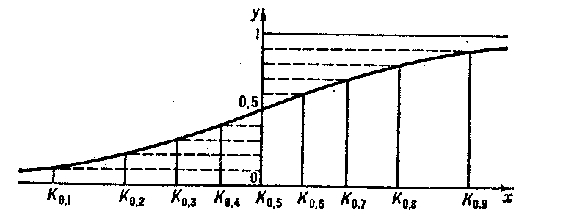|
|
| Line 1: |
Line 1: |
| | + | {{TEX|done}} |
| | {{MSC|60-01|62-01}} | | {{MSC|60-01|62-01}} |
| | | | |
| − | One of the numerical characteristics of a [[Probability distribution|probability distribution]]. For a real random variable <img align="absmiddle" border="0" src="https://www.encyclopediaofmath.org/legacyimages/q/q076/q076270/q0762701.png" /> with distribution function <img align="absmiddle" border="0" src="https://www.encyclopediaofmath.org/legacyimages/q/q076/q076270/q0762702.png" />, by a quantile of order <img align="absmiddle" border="0" src="https://www.encyclopediaofmath.org/legacyimages/q/q076/q076270/q0762704.png" />, <img align="absmiddle" border="0" src="https://www.encyclopediaofmath.org/legacyimages/q/q076/q076270/q0762705.png" />, one means the number <img align="absmiddle" border="0" src="https://www.encyclopediaofmath.org/legacyimages/q/q076/q076270/q0762706.png" /> for which <img align="absmiddle" border="0" src="https://www.encyclopediaofmath.org/legacyimages/q/q076/q076270/q0762707.png" />, <img align="absmiddle" border="0" src="https://www.encyclopediaofmath.org/legacyimages/q/q076/q076270/q0762708.png" />. If <img align="absmiddle" border="0" src="https://www.encyclopediaofmath.org/legacyimages/q/q076/q076270/q0762709.png" /> is a continuous strictly-monotone function, then <img align="absmiddle" border="0" src="https://www.encyclopediaofmath.org/legacyimages/q/q076/q076270/q07627010.png" /> is the unique solution of the equation <img align="absmiddle" border="0" src="https://www.encyclopediaofmath.org/legacyimages/q/q076/q076270/q07627011.png" />, that is, <img align="absmiddle" border="0" src="https://www.encyclopediaofmath.org/legacyimages/q/q076/q076270/q07627012.png" /> is the function of <img align="absmiddle" border="0" src="https://www.encyclopediaofmath.org/legacyimages/q/q076/q076270/q07627013.png" /> inverse to the function <img align="absmiddle" border="0" src="https://www.encyclopediaofmath.org/legacyimages/q/q076/q076270/q07627014.png" />. If <img align="absmiddle" border="0" src="https://www.encyclopediaofmath.org/legacyimages/q/q076/q076270/q07627015.png" /> is continuous and <img align="absmiddle" border="0" src="https://www.encyclopediaofmath.org/legacyimages/q/q076/q076270/q07627016.png" />, then the probability of the inequality <img align="absmiddle" border="0" src="https://www.encyclopediaofmath.org/legacyimages/q/q076/q076270/q07627017.png" />, is equal to <img align="absmiddle" border="0" src="https://www.encyclopediaofmath.org/legacyimages/q/q076/q076270/q07627018.png" />. The quantile <img align="absmiddle" border="0" src="https://www.encyclopediaofmath.org/legacyimages/q/q076/q076270/q07627019.png" /> is the [[Median (in statistics)|median (in statistics)]] of the random variable <img align="absmiddle" border="0" src="https://www.encyclopediaofmath.org/legacyimages/q/q076/q076270/q07627020.png" />. The quantiles <img align="absmiddle" border="0" src="https://www.encyclopediaofmath.org/legacyimages/q/q076/q076270/q07627021.png" /> and <img align="absmiddle" border="0" src="https://www.encyclopediaofmath.org/legacyimages/q/q076/q076270/q07627022.png" /> are called the quartiles, and <img align="absmiddle" border="0" src="https://www.encyclopediaofmath.org/legacyimages/q/q076/q076270/q07627023.png" />, the deciles. The values of the quantiles for suitable values of <img align="absmiddle" border="0" src="https://www.encyclopediaofmath.org/legacyimages/q/q076/q076270/q07627024.png" /> enable one to form an idea about the distribution function. | + | One of the numerical characteristics of a [[Probability distribution|probability distribution]]. For a real random variable $X$ with distribution function $F$, by a quantile of order $p$, $0<p<1$, one means the number $K_p$ for which $F(K_p)\leq p$, $F(K_p+0)\geq p$. If $F$ is a continuous strictly-monotone function, then $K_p$ is the unique solution of the equation $F(x)=p$, that is, $K_p$ is the function of $p$ inverse to the function $F$. If $F$ is continuous and $p'>p$, then the probability of the inequality $K_p<X<K_{p'}$, is equal to $p'-p$. The quantile $K_{1/2}$ is the [[Median (in statistics)|median (in statistics)]] of the random variable $X$. The quantiles $K_{1/4}$ and $K_{3/4}$ are called the quartiles, and $K_{0.1},\ldots,K_{0.9}$, the deciles. The values of the quantiles for suitable values of $p$ enable one to form an idea about the distribution function. |
| | | | |
| | For example, for the [[Normal distribution|normal distribution]] (see Fig.) | | For example, for the [[Normal distribution|normal distribution]] (see Fig.) |
| | | | |
| − | <table class="eq" style="width:100%;"> <tr><td valign="top" style="width:94%;text-align:center;"><img align="absmiddle" border="0" src="https://www.encyclopediaofmath.org/legacyimages/q/q076/q076270/q07627025.png" /></td> </tr></table>
| + | $$\Phi(x)=\frac{1}{\sqrt{2\pi}}\int\limits_{-\infty}^xe^{-t^2/2}dt$$ |
| | | | |
| − | the graph of the function <img align="absmiddle" border="0" src="https://www.encyclopediaofmath.org/legacyimages/q/q076/q076270/q07627026.png" /> can be drawn from the deciles: <img align="absmiddle" border="0" src="https://www.encyclopediaofmath.org/legacyimages/q/q076/q076270/q07627027.png" />; <img align="absmiddle" border="0" src="https://www.encyclopediaofmath.org/legacyimages/q/q076/q076270/q07627028.png" />; <img align="absmiddle" border="0" src="https://www.encyclopediaofmath.org/legacyimages/q/q076/q076270/q07627029.png" />; <img align="absmiddle" border="0" src="https://www.encyclopediaofmath.org/legacyimages/q/q076/q076270/q07627030.png" />; <img align="absmiddle" border="0" src="https://www.encyclopediaofmath.org/legacyimages/q/q076/q076270/q07627031.png" />; <img align="absmiddle" border="0" src="https://www.encyclopediaofmath.org/legacyimages/q/q076/q076270/q07627032.png" />; <img align="absmiddle" border="0" src="https://www.encyclopediaofmath.org/legacyimages/q/q076/q076270/q07627033.png" />; <img align="absmiddle" border="0" src="https://www.encyclopediaofmath.org/legacyimages/q/q076/q076270/q07627034.png" />; <img align="absmiddle" border="0" src="https://www.encyclopediaofmath.org/legacyimages/q/q076/q076270/q07627035.png" />. | + | the graph of the function $\Phi$ can be drawn from the deciles: $K_{0.1}=-1.28$; $K_{0.2}=-0.84$; $K_{0.3}=-0.52$; $K_{0.4}=-0.25$; $K_{0.5}=0$; $K_{0.6}=0.25$; $K_{0.7}=0.52$; $K_{0.8}=0.84$; $K_{0.9}=1.28$. |
| | | | |
| | <img style="border:1px solid;" src="https://www.encyclopediaofmath.org/legacyimages/common_img/q076270a.gif" /> | | <img style="border:1px solid;" src="https://www.encyclopediaofmath.org/legacyimages/common_img/q076270a.gif" /> |
| Line 13: |
Line 14: |
| | Figure: q076270a | | Figure: q076270a |
| | | | |
| − | The quartiles of the normal distribution <img align="absmiddle" border="0" src="https://www.encyclopediaofmath.org/legacyimages/q/q076/q076270/q07627036.png" /> are <img align="absmiddle" border="0" src="https://www.encyclopediaofmath.org/legacyimages/q/q076/q076270/q07627037.png" /> and <img align="absmiddle" border="0" src="https://www.encyclopediaofmath.org/legacyimages/q/q076/q076270/q07627038.png" />. | + | The quartiles of the normal distribution $\Phi$ are $K_{1/4}=-0.67$ and $K_{3/4}=0.67$. |
| | | | |
| | | | |
Latest revision as of 16:40, 5 August 2014
2020 Mathematics Subject Classification: Primary: 60-01 Secondary: 62-01 [MSN][ZBL]
One of the numerical characteristics of a probability distribution. For a real random variable $X$ with distribution function $F$, by a quantile of order $p$, $0<p<1$, one means the number $K_p$ for which $F(K_p)\leq p$, $F(K_p+0)\geq p$. If $F$ is a continuous strictly-monotone function, then $K_p$ is the unique solution of the equation $F(x)=p$, that is, $K_p$ is the function of $p$ inverse to the function $F$. If $F$ is continuous and $p'>p$, then the probability of the inequality $K_p<X<K_{p'}$, is equal to $p'-p$. The quantile $K_{1/2}$ is the median (in statistics) of the random variable $X$. The quantiles $K_{1/4}$ and $K_{3/4}$ are called the quartiles, and $K_{0.1},\ldots,K_{0.9}$, the deciles. The values of the quantiles for suitable values of $p$ enable one to form an idea about the distribution function.
For example, for the normal distribution (see Fig.)
$$\Phi(x)=\frac{1}{\sqrt{2\pi}}\int\limits_{-\infty}^xe^{-t^2/2}dt$$
the graph of the function $\Phi$ can be drawn from the deciles: $K_{0.1}=-1.28$; $K_{0.2}=-0.84$; $K_{0.3}=-0.52$; $K_{0.4}=-0.25$; $K_{0.5}=0$; $K_{0.6}=0.25$; $K_{0.7}=0.52$; $K_{0.8}=0.84$; $K_{0.9}=1.28$.

Figure: q076270a
The quartiles of the normal distribution $\Phi$ are $K_{1/4}=-0.67$ and $K_{3/4}=0.67$.
References
How to Cite This Entry:
Quantile. Encyclopedia of Mathematics. URL: http://encyclopediaofmath.org/index.php?title=Quantile&oldid=26931
This article was adapted from an original article by V.V. Senatov (originator), which appeared in Encyclopedia of Mathematics - ISBN 1402006098.
See original article